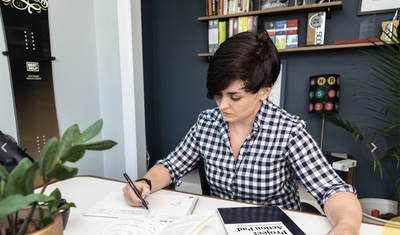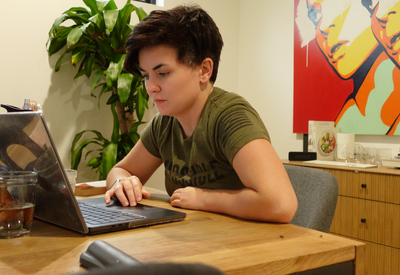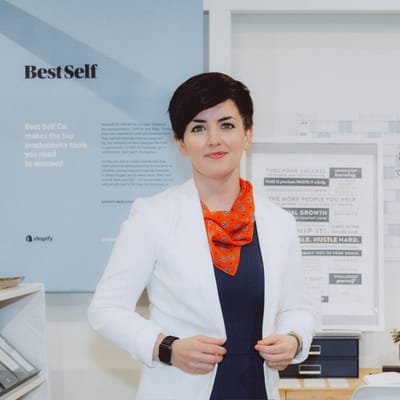
In August 2015, we launched a Kickstarter campaign to fund our new product, SELF Journal.
This started as a passion project and after a successful Kickstarter campaign, it emerged as a business.
I’m going to walk you through the exact process we used to figure out where to launch, when to launch, how much to ask for, and everything else along the way that we used to generate $322,696 in funding and later over $75K in pre-orders.
This is a 5,000+ word guide to Crowdfunding. Before you continue, bookmark this page now because you’ll want to return to it later.
I’ll share what we did right, what we did wrong, and everything in between.
A few caveats before we start:
- Launching on Kickstarter is a whole lot of work. If you’re looking for a get-rich-quick scheme, this isn’t it.
- I wrote this to explain step-by-step how we did it to bring clarity to the process and show you what’s possible from people who started with just an idea, no list, and no internet fame.
- My goal is for you to finish this post thinking “I can do that.” and then for you to email me in six months and share the results of your launch.
Part I: Why Crowdfund?
First off, why did we decide to go to Kickstarter in the first place? Mainly because crowdfunding is the ultimate tool for validation. There’s no better way to test demand for your product or service than to ask people to pay ahead of time. This takes a large part of the risk out of creating a new product as you’re not shelling out a chunk of money for an initial run just hoping that people will want it.
The best part about crowdfunding is that you can build a community around your product and even get incredible feedback on how to make it better.
If you decide that crowdfunding makes sense for your situation, you should have the following ready to go before moving forward:
A working prototype
Knowledge of production and how you will deliver to backers
Associated costs from launch to delivery
Kickstarter vs. Indiegogo?
Lots of people asked me why I have a preference for Kickstarter over Indiegogo because Kickstarter has an all-or-nothing model which means if you don’t raise your minimum goal you walk away with nothing. Alternately, Indiegogo has a flexible funding option wherein if you don’t reach your goal you can still keep the money you raised.
Personally, I don’t like the idea of flexible funding. The whole point of crowdfunding is to set a minimum goal you have to reach to bring the product to life. If it doesn’t hit the minimum how will you still deliver to backers without the full amount – and more importantly, is it really validated?
I don’t think so. More on this later.
Here’s a chart of the main differences between the two platforms:
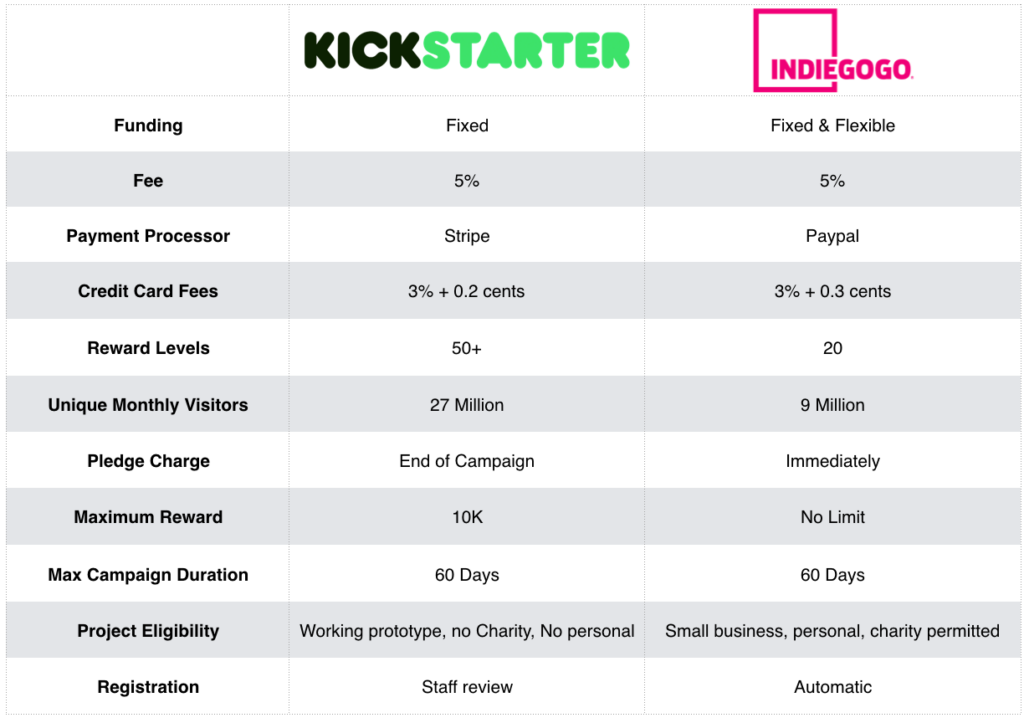
We chose Kickstarter because besides receiving much more traffic than Indiegogo statistically, I have personally backed many more Kickstarter campaigns than those on Indiegogo. I feel people browse and “Shop” on Kickstarter, and the organic traffic it brings as part of the community is hugely useful.
However, as shown above, each platform has different strengths and weaknesses.|
Part II: Campaign decisions
1. Who + Why
Kickstarter is a perfect vehicle to share the story behind you as the creator and why you started on the mission for this product. We wanted to introduce ourselves and the story of why we created the SELF Journal and what problem we were solving.
Creating a new product is an incredibly personal experience. The story behind who you are as a creator and why you started this mission is what enables people to fall in love with your story and is what will help you build a tribe around the product.
“People don’t buy what you do, they buy why you do it.” – Simon Sinek
The questions you should ask yourself before you launch are:
Who is the project for?
Where do they spend their time online?
What is the best most economical way to grab their attention?
How can you add more value to your campaign to help these potential backers even before the product is delivered?
By asking yourself these key questions ahead of time, you will be able to target the right people with your marketing, message, and product, sniper-style, rather than trying the shotgun approach and hitting everyone (and wasting time/money).
2. Length of time
You can choose any length of time up to 60 days for your campaign. However, doing a longer campaign will not necessarily mean raising more money. Check out Kicktraq to research the funding graph of similar campaigns, typically the first and last week of the campaign drive the most pledges.
As I mentioned above, Kickstarter is A LOT of work if you want to do it right, so running a longer campaign comes with a longer time and energy investment. Do some research so you can ensure it will pay off.
“Kickstarter is a marathon, not a sprint” – Someone, sometime, probably said this.
We wanted to launch and end during a time when people are online most, which is typically during the week rather than a weekend. Therefore, we launched on Wednesday, August 19th at 11 am and ended Tuesday, September 22nd at 10 pm.
Total campaign time: 35 days.
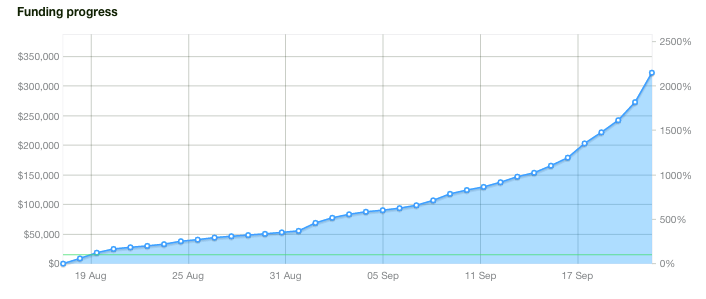
3. Choosing a Launch Date
It’s important to launch your Kickstarter during the time of the year when people will resonate with your product.
For the SELF Journal, while we technically could have launched in July (we had everything ready), we chose to wait until late August when people were in “back to school mode” and thinking about getting organized.
Another important thing for us is that we wanted to ship by the beginning of December so that backers could have it in time for the new year.
Having these key timeline constraints helped us to plan our campaign accordingly.
Does the time of year really make a difference with Kickstarter?
Yes.
The greatest example of this I have seen is with the Coolest Cooler, which in 2014 became the most funded project ever at over $13M. However, it had surprisingly failed the first time around to raise only $125K.
The creator, Ryan, has stated that one of the biggest reasons for the failure was that the first project was launched in December, at a time when people weren’t resonating with needing a cooler.
When it was re-launched in July (besides having an updated prototype) it was during the prime summertime season when people were thinking about needing that specific type of product.
Lastly don’t launch on a weekend as people are online much less than during the week, it’s also going to be more challenging to get press coverage on launch day if it’s a weekend.
Takeaway: Launch when your target market is thinking about your product and when your audience will be online.
4. Minimum funding goal
Your funding goal is hugely subjective to the product you’re selling, so there’s no hard and fast rule. The key is to know the minimum amount of money you need to successfully produce and deliver to backers.
Why do we ask for the minimum rather than going higher?
Momentum matters in Kickstarter, and quickly succeeding in your goal can go a long way with backers than struggling to hit a higher number. People want to be on the winning team, and despite the fact that if the project fails, backers will get their money back, people are much less likely to back if they feel you will not be successful.
By looking at other campaigns and our production costs, we decided that the crucial factor for us was picking a fund goal we could surpass quickly while still being able to deliver.
$15K ended up our number.
We hit that goal within 28 hours…. Ahhh, sweet momentum.
5. Reward levels
Every new reward level is a new complication to your delivery. Backers are there for the main product, not some swag with your company branding on it that you feel you have to put on just to have another backer level.
Keep it simple.
We stuck with multiples of the SELF Journal as well as early bird deals:
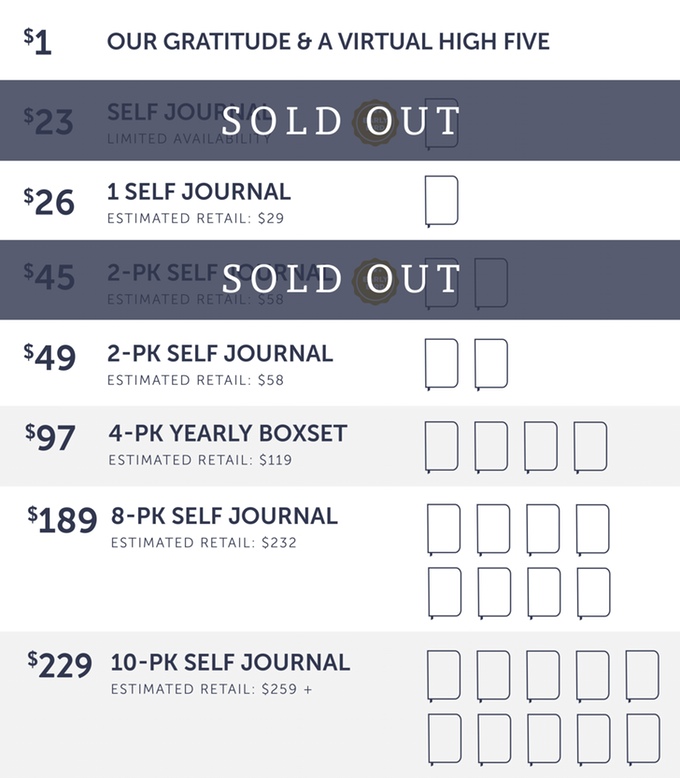
Earlybird Rewards
The early bird deals are a great way to get those initial pledges in during those first 48 hours which builds initial momentum for your campaign. Our early bird deal was just $3 off the regular price of $26, but it was enough that these levels sold out quickly and gave us some initial momentum.
Here are some options you can consider for Earlybird levels:
A small discount
Earlier delivery
Limited edition version
Bonus gift included
These reward levels should be limited as it creates scarcity and therefore, visitors are more likely to back quickly than procrastinate on it. We limited ours to 250 backers per Earlybird reward.
How do you know what to limit the early bird rewards to?
We chose 250 per Earlybird reward, so 500 total. The strategy behind this is that selling out of these limited specials would bring us over our minimum fund goal, which would mean we would be successfully funded over $15,000.
The Earlybird Numbers:
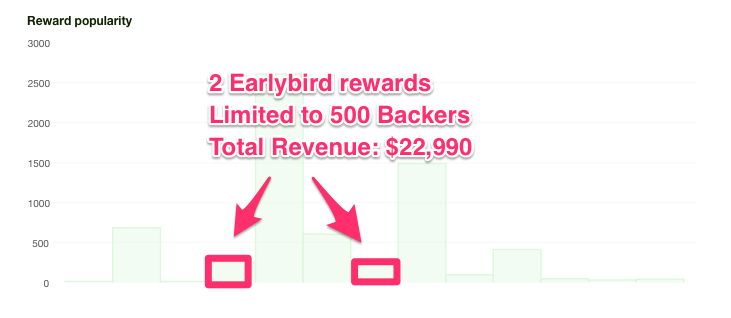
Our very limited early bird rewards were 153% of our funding goal
Part III: Creating the Campaign Assets
The video:
If you’re considering crowdfunding without a video, I urge you to reconsider. MWP research of 7,196 projects revealed that projects that have a Kickstarter video are 85% more likely to achieve their funding goal.
People’s attention span is getting shorter and shorter all the time. Therefore your video needs to be concise. Being succinct is tough, so it’s important that you write the script ahead of time and edit, edit, and edit some more until you distill it down to the essence of your message.
“I would have written a shorter letter, but I did not have the time.” – TS Eliot.
Video tips:
Write your script and time yourself before you shoot anything.
Create a storyboard with all the shots you want to capture as well as who will be appearing and where you’ll be shooting. The more detail and consideration you put into this part ahead of time the less stressed you’ll be on the day(s).
Show different use cases within the video itself so you’re relating to your target audience. You should know this from when you wrote out who the project was for.
Share the storyboard, script, and inspiration shots with the camera person ahead of time so they can prepare accordingly.
Music choice is critical to set the mood and should be selected ahead of time. Ensure you have permission to use it so you don’t get into trouble later. We got a song from this site.
Get feedback constantly! Ask people who don’t know the product to watch your video and see if they have any questions.
Crafting the Campaign page:
It’s important to craft the Kickstarter page as if it’s a product in itself. A polished campaign page with exceptional photography and graphics makes a huge difference in developing backer trust.
If you don’t have one already, hire a designer for this!
Our page was organized into the following sections:
Introduction: What we do, who we are, and why we created SELF Journal.
Social Proof: Logos of podcasts, and blogs we’ve appeared on
Unique Selling Proposition: Telling our story and sharing what makes our product different
Social Share: An offer to entice people to share, in exchange, we give them a free PDF bundle.
Specs & Features: The nitty gritty details about the physical features and specifications of the journal, including the layouts.
Testimonials: Quotes of what people have said about us.
Rewards: A graphic representation of the rewards we offer (much clearer to read than the default Kickstarter side panel)
Project Timeline: Our planned schedule for the campaign, production and delivery
Part IV: Planning your Pre-Launch
It’s important to get off to a running start with Kickstarter so planning an effective pre-launch is crucial to success.
Here are some things to do to pre-launch successfully:
1. Build an Email List
The first 48 hours on Kickstarter are crucial since this is when the first jolt of backers will pledge money to your campaign. Once you show Kickstarter that people dig your project, their algorithm will do its thing, and you’ll show up under the ‘popular projects’ and perhaps even the first page, like this:
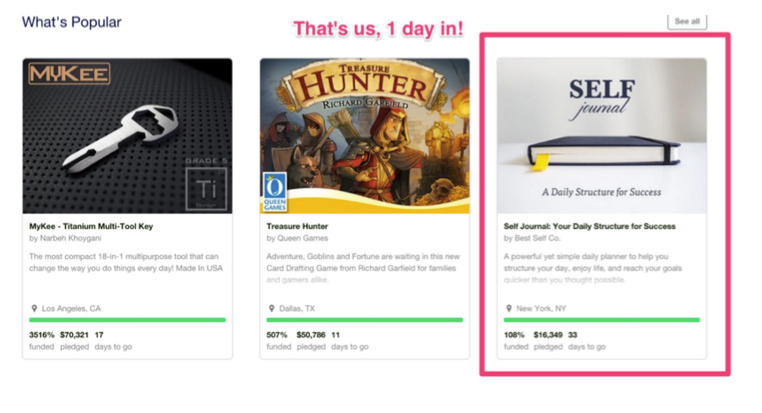
But you won’t get featured on the front page if you don’t have that initial surge of sales, and the best way to get that initial surge is to build an email list of people who can’t wait to get it.
We had a list of 3,025 people that we built up between May and August. I wrote a very detailed post on exactly how we created that list over at SumoMe.
2. Create a Media List
Creating a media list is incredibly useful as it’s a highly-targeted list of relevant sites that have covered similar projects to yours that you can reach out to for coverage. The task of creating this list can be delegated easily to a Virtual Assistant. I’ve figured out two ways to do this, one with BuzzSumo and the other is more time-consuming with Google Images.
Option 1: Find Relevant Websites/Blogs Using BuzzSumo:
BuzzSumo is an excellent tool for analyzing content so you can find key influencers in your niche efficiently. It speeds up the media list process incredibly. Here’s how it works:
1. Get the Kickstarter URL for 10 Kickstarter projects that serve your same audience
2. Go to the Content Research tab of BuzzSumo
3. Paste the Kickstarter URL into the area provided:

4. Export results into an Excel sheet, this will give you a database of incredibly useful information such as:
Article URL
Date Published
Social shares; segmented out by Facebook/Twitter/LinkedIn/Pinterest
Author Name
Option 2: Find Relevant Websites/Blogs Using Google Images:
Find 5–10 Kickstarter projects either similar to yours or that serve the same audience as your campaign will.
Save the main project images for each to your computer.
Use Google Images to search for images:
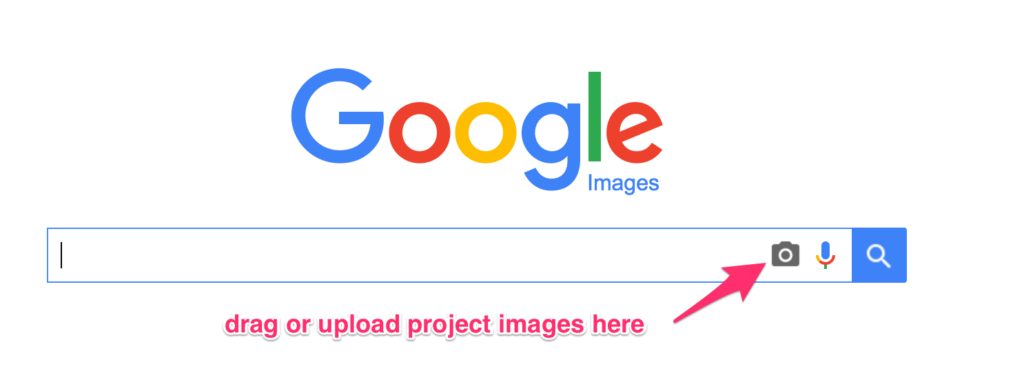
4. On the Google results page review the top results
5. Create a spreadsheet with all relevant data
Once you have your media list of important contacts you can start planning your outreach. You should write all your emails ahead of time and schedule them in advance; I use Followup.cc for this.
3. How to reach out to Media list/Influencers
Bloggers and influencers get bombarded daily with pitch emails. 99% of these emails will go straight to the trash because they do it all wrong.
You need to make it as easy as possible for them to write about your project which means giving them all the information up front in a short and engaging format. No back-and-forth emails that create friction for them.
The first step is to create a press folder with:
Product images (both high-res and low-res image sizes)
Description of the product
Your project video
Any additional information that seems relevant
Essentially the less amount of work you make a blogger do, the better. With a good pitch and organized information and assets, it’s a much easier decision for them to talk up your project.
Here are some tips for crafting your emails:
Keep it short, sweet and personal. Do not mass email these people, you should craft each email to the individual or blog you’re approaching.
Link to a folder of professional assets (images/text/video etc.)
Name and Date of project launch with link (to either preview page or landing page)
By doing all of these things you will automatically put yourself way in front of most people that they receive emails from, and you will be considered professional.
4. Set Up Google Analytics
Kickstarter just integrated with Google Analytics last year which is awesome for tracking conversion, traffic and digging down to what’s working.
Part V: Content Marketing
Due to the nature of our product, we wanted to focus on content marketing for our Kickstarter launch, both before and during to build up interest and get traffic to the campaign.
One of the ways we did this was by writing complimentary articles on the topics of productivity, goal setting and creating habits. We did this to focus our audience on the product we were hoping they would get behind.
How we used Medium:
Beginning around 4–5 weeks before launch we started pushing new and some existing content onto Medium, a blogging platform. We did this so we could expand our reach to gain more email subscribers before the launch. Here are the articles posted before the launch:
The Jerry Seinfeld and John Grisham Productivity Hack
What Stephen Curry Can Teach Us About Creating Successful Habits
Why Creating a Meaningful Morning Routine Will Make You More Successful
Nightly Routines and How To Sleep Hack Your Way to a Productive Morning
The 22 Books to Read Before you Quit Your Job
When I wrote the articles, I would pass them to Allen, who would syndicate them across social media, and relevant websites such as Reddit, Forums, and Facebook groups. This is what drove a large amount of traffic and recommendations to these posts.
Some ended up getting more traction than others:
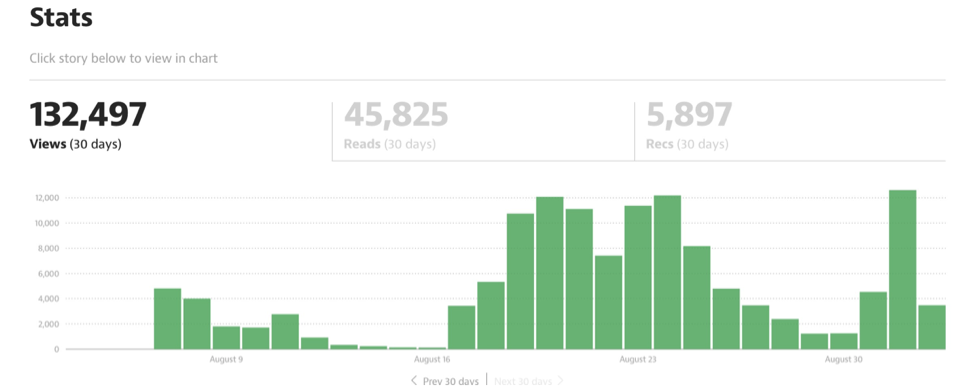
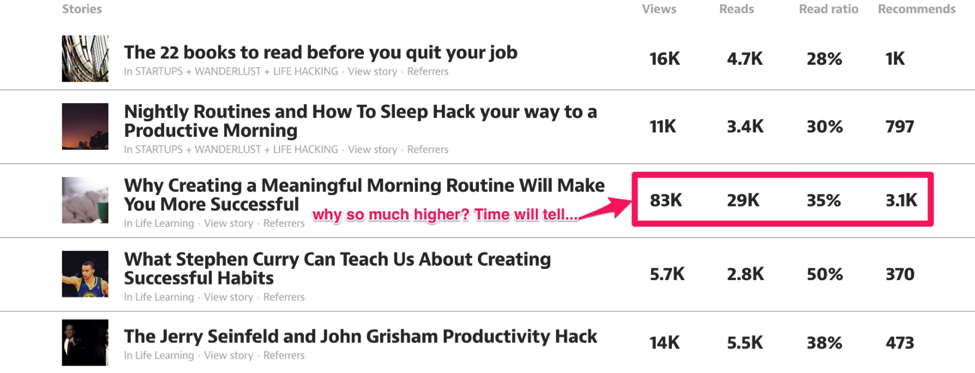
Arianna Huffington happened to tweet out my Medium.com article the same day our Kickstarter launched. This is why our stats for that post are a great deal higher than the others.
For each blog post we put out, we created a premium piece of content that we would give to our readers in exchange for their email addresses. For example, in one article we had this CTA at the bottom:
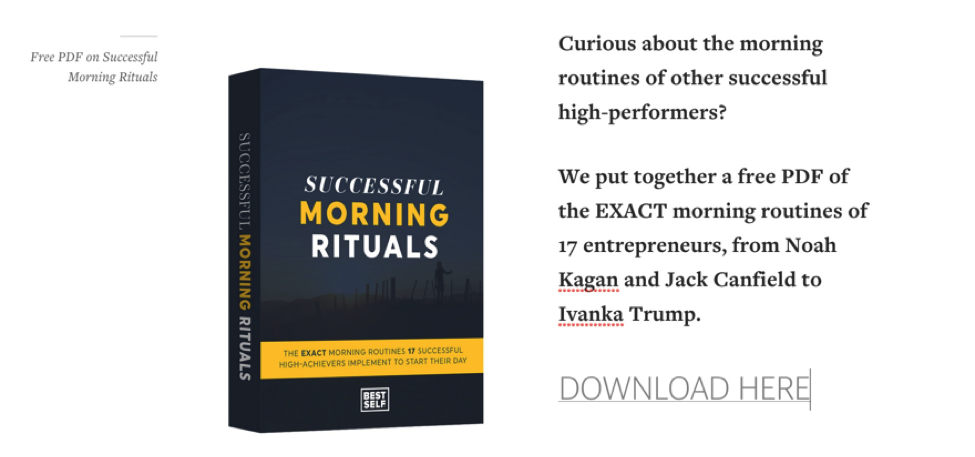
We used this to collect 600+ email addresses in just a few weeks. Once the campaign went live we changed these to an image of the campaign:
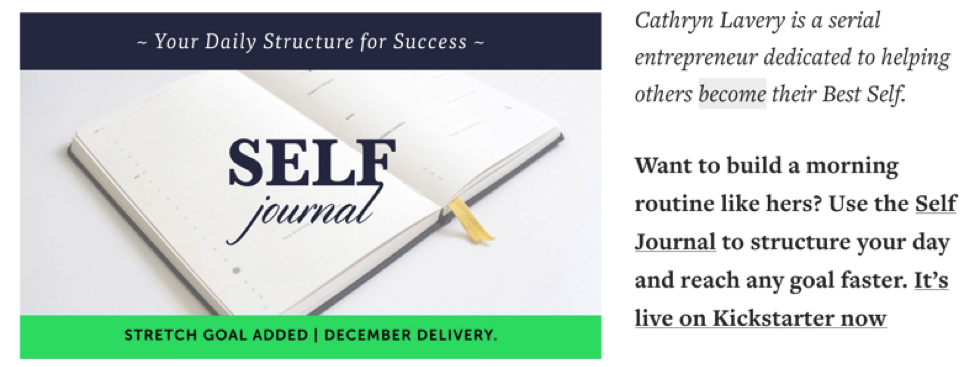
Once the Kickstarter campaign went live, I changed the end of the campaign to go right to the Kickstarter project.
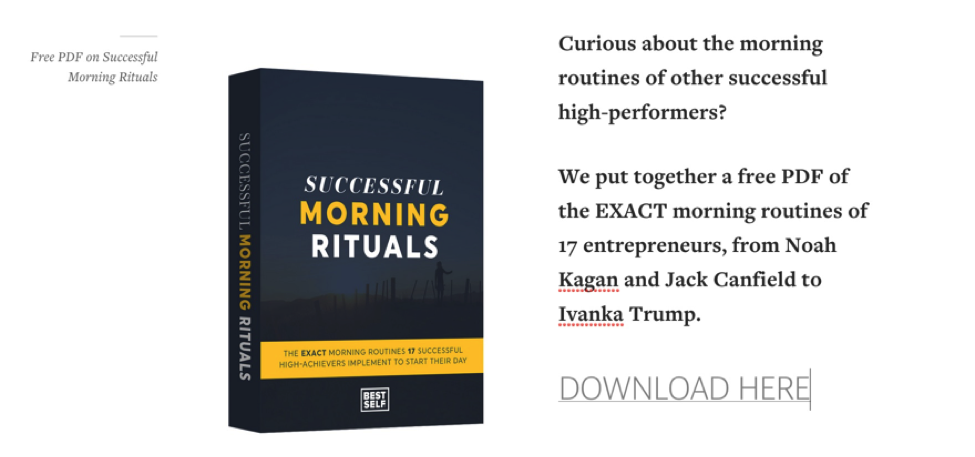
This direct traffic drove $3,442 in pledges in the first 7 days:

Part VI: Stretch Goals
You need to think before you stretch and ask yourself these questions:
Will this stretch goal drive more pledges?
Does this increase the complexity of delivery? If so, by how much?
Does the stretch goal risk the timeline of the entire project?
One of the questions we asked early on in the campaign was: How can we add more value to your campaign to help these potential backers even before the product is delivered?
That’s where the idea of partnerships from complimentary products came in, preferably digital.
Setting up a Partnership with Blinkist
Blinkist is a product that has taken 1,000+ non-fiction books and distilled them into the key takeaways from each that you can digest in only 15 minutes.
Considering SELF Journal had emerged from distilling down the powerful principles and success tactics that I had learned and applied from reading many of these books – it seemed like a great partnership.
I reached out to Blinkist on Twitter to get a contact email:
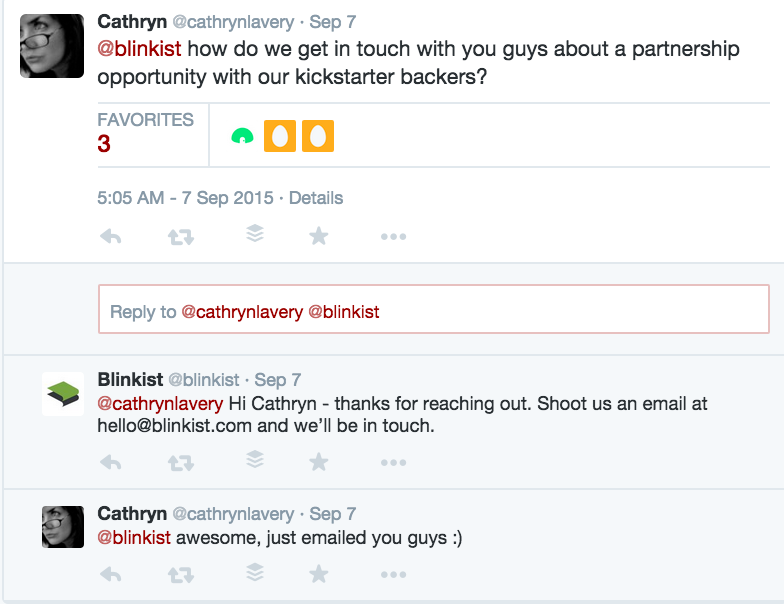
I then emailed them this email:
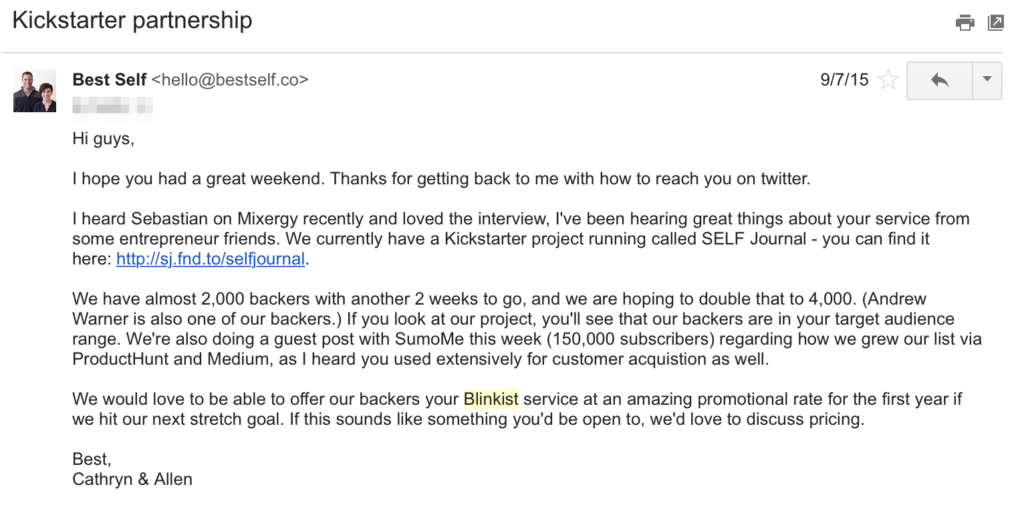
It only took a few days to come to an agreement of what we could offer backers. We ended up getting all of our backers a 6-month deal on the premium plan (usually $79.99 per year).
Did I mention we paid nothing to Blinkist for this?
Booosh!
This was offered as part of our 125K stretch goal to everyone who backed at a SELF Journal level. This was a huge added value for backers as now for buying a SELF journal for as little as $26 they would be getting a 6-month membership worth $39.99 and a wall calendar.
The Blinkist drove many additional pledges for those who were on the edge. Check out this one backer, Niklas, who ended up turning his Blinkist deal into a whole project of its own:
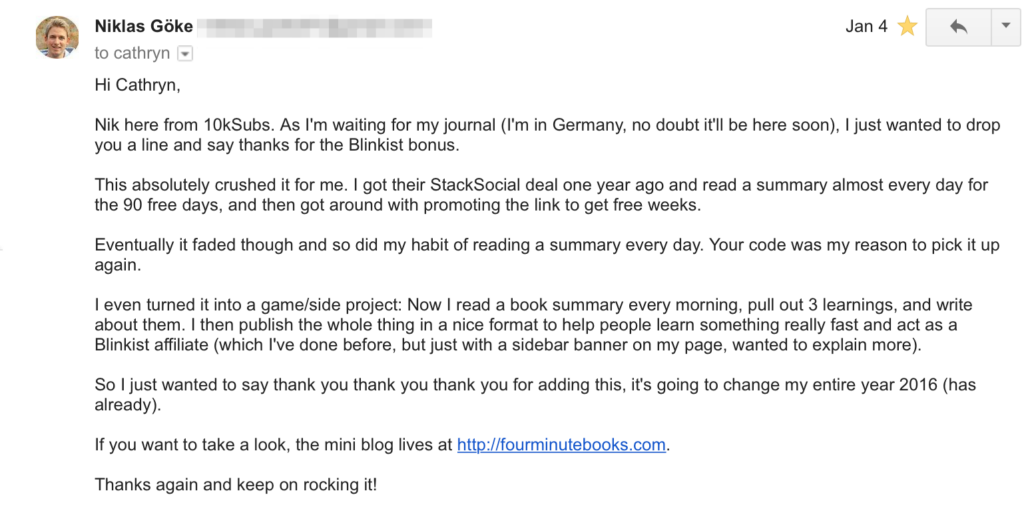
How we stretched:
It was before we hit the 50K mark that we started thinking about stretch goals we could offer besides additional physical products and changing the SELF Journal further.
While providing a Kickstarter-only limited edition may have been cool, I don’t think it would have driven many more pledges and the cost to us would have been substantial. Not to mention the added complication of having two different journal types, one for Kickstarter people and another for the store.
You have to think of all the possible implications before you stretch.
When we launched our campaign, we had already planned out our first stretch goal which was going to be a dry-erase wall calendar. We had originally planned to put it in the campaign from the start, however on review, we considered it to be an information overload for backers and wanted to keep it simple.
Here are our stretch goals:
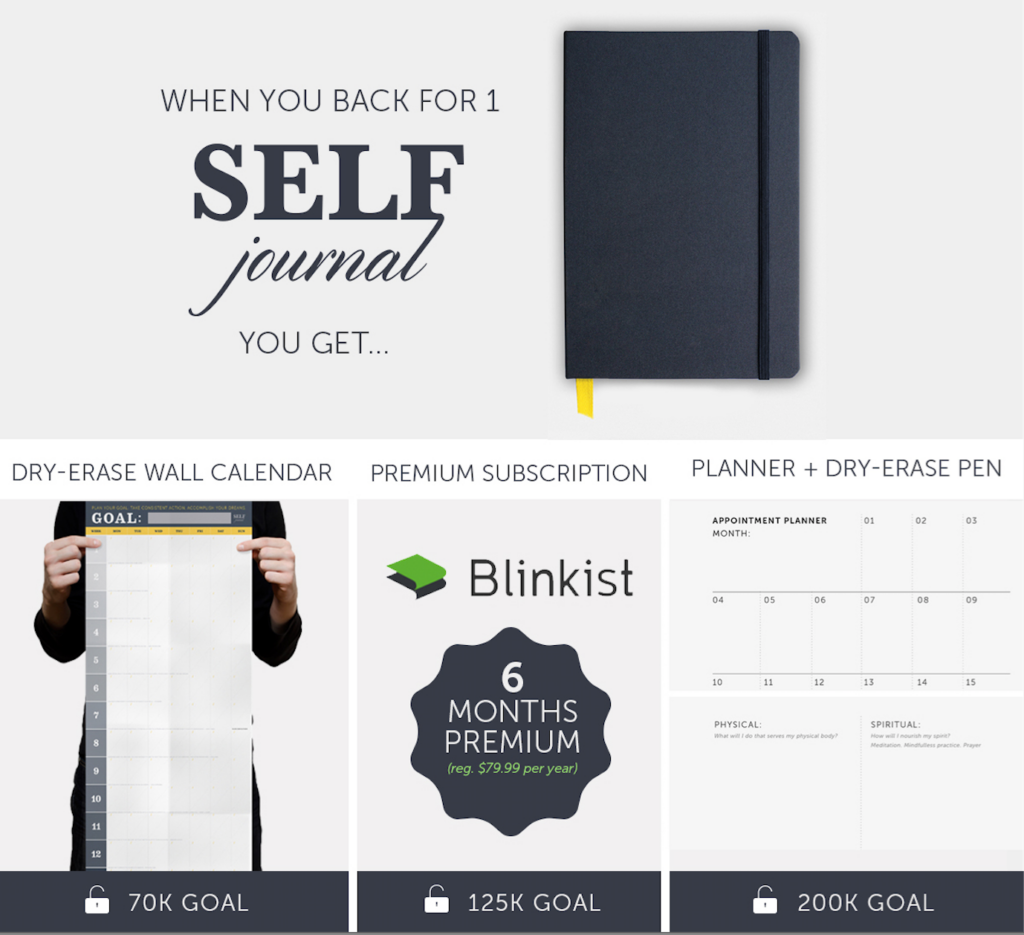
We heard from many backers that the Blinkist deal for them has what pushed them over the edge as it seemed like a no-brainer. This is when knowing your target audience pays off.
Cross Promotions
An under-utilized way to get more backers as effectively and economically as possible is to do a cross-promotion with another campaign that targets a similar audience.
For our SELF Journal campaign, this was the single most influential thing we did, accounting for over 40K in funding revenue alone.
The key to this is reaching out to other creators once you have a good number of backers yourself. If you do this when you just begin and haven’t got many people, then you have nothing to offer the other campaigns in return.
A good rule of thumb is to reach out to other creators that:
Have a complimentary product, OR
Serve a very similar audience
Have a similar number of backers to your campaign
Our most successful cross-promotion was with the BauBaux Travel Jacket. While they had 4X the backers as we did their lowest tier was $130, which was 4–6 times what ours was. Therefore, it made sense for us both because 1 of our backers was worth that much more.
We also committed not to promote any other projects in our update with them, whereas we were 1 of 4 projects included in their update. As the project with many more backers, they had the advantage.
That cross-promotion was worth over $16K to our project:

Tip: You should back any campaign you cross-promote, even if it’s only at a $1 level. Backers can see that you supported it, and it looks better. I backed at a $140 level to get my own Travel Jacket… but that’s just because I dug the project.
Setting up Pre-Orders
After the Kickstarter campaign ends, it takes two weeks for the transfer of the money to go through. During this time, we wanted to be able to accept preorders, so we set up Celery (now defunct) to handle this. This was crucial to ensure we took advantage of the traffic that was still coming out way after the campaign had ended. In the seven days after the campaign, we drove 14K in additional funding without doing any marketing.
Our overall total in Celery

We moved to Backerkit after 2.5 weeks and started taking pre-orders through there.
Fulfillment
Fulfillment is almost always the toughest part of any Kickstarter campaign, especially if you’re delivering a physical product as we were. Something I wanted to ensure was that our backers enjoyed a positive experience with each SELF Journal, which included paying particular attention to the packaging.
Paying $18 postage = Friction
One significant decision we made as our European Kickstarter backers increased was to get a fulfillment center in Europe as well as one in the U.S. By doing this we were making the re-purchase of the SELF Journal as frictionless as possible.
Despite the additional cost for us, by doing this ahead of time, we were setting up the infrastructure for long-term success and providing extra value to our supporters in the UK and Europe.
Here’s how it looked: UK Warehouse: The UK + Europe orders
US warehouse: All other orders
It takes around two weeks to receive your funding once your campaign is over so you should bear that in mind when planning your timeline. We sent our first 20% downpayment to our manufacturer before receiving this as we did not want to hold up manufacturing.
Once you receive the funding, it’s time to send surveys to your Backers to begin reward fulfillment. We used Backerkit for this part, mainly because as awesome as Kickstarter is, it doesn’t make delivering rewards very easy for creators. We needed robust surveys so we could establish a few things:
Name & address
Additional items requested
We used the ASK formula by Ryan Levesque to ask three questions to get to know our backers better so we could know how to serve them better in the future.
Our survey using ASK Formula:
What is the single biggest challenge that you’re struggling with in your business/life/goal-setting process, etc, right now?
Which of the following best describes you (multiple choice)
What attracted you to the SELF Journal Project and how do you think it will improve your life?
Tools We Used:
KickTraq: Great site to track your project as well as research similar projects before launch.
ConvertKit: Great email marketing software for building an email list. Autoresponder to send out shareable PDF.
URL Builder: For creating custom links quickly to measure which traffic sources are driving the most pledges/conversion/email opt-ins.
Bit.ly: A URL shortener that makes it easy to track the links you send people, you can use this in conjunction with URL Builder
Dropbox:: To keep all the professional assets and project documents in one place
Epidemic Sound: Royalty Free Music for your video undefined
Shopify: An awesome and easy E-Commerce platform.
Become a subscriber receive the latest updates in your inbox.

